BUS5IAF: Shareholder Value Creation at Billabong International Ltd
VerifiedAdded on 2023/03/24
|10
|2380
|49
Report
AI Summary
This report presents a financial analysis of Billabong International Limited, focusing on debt and share valuation, cost of capital, and market analysis. It examines the company's debt structure, cost of equity, and weighted average cost of capital (WACC). The analysis includes a review of Billabong's revenue, earnings, EPS, and dividend performance, revealing declining financial health over the past five years. The report also discusses the impact of the retail industry on Billabong's debt proportion and optimal capital structure, concluding with an assessment of the company's overall business performance and recommendations for improvement. Desklib offers a wide range of solved assignments and past papers to aid students in their studies.
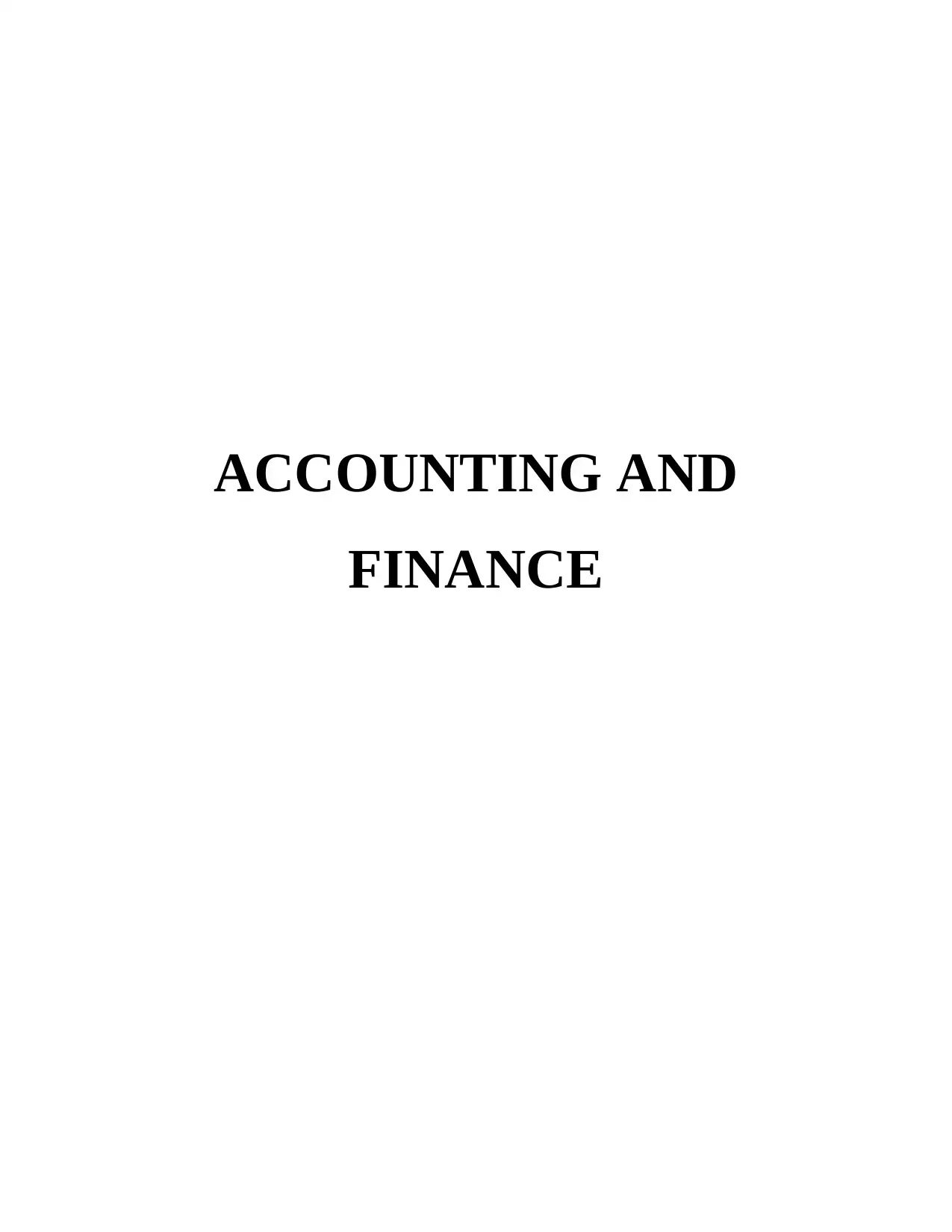
ACCOUNTING AND
FINANCE
FINANCE
Paraphrase This Document
Need a fresh take? Get an instant paraphrase of this document with our AI Paraphraser
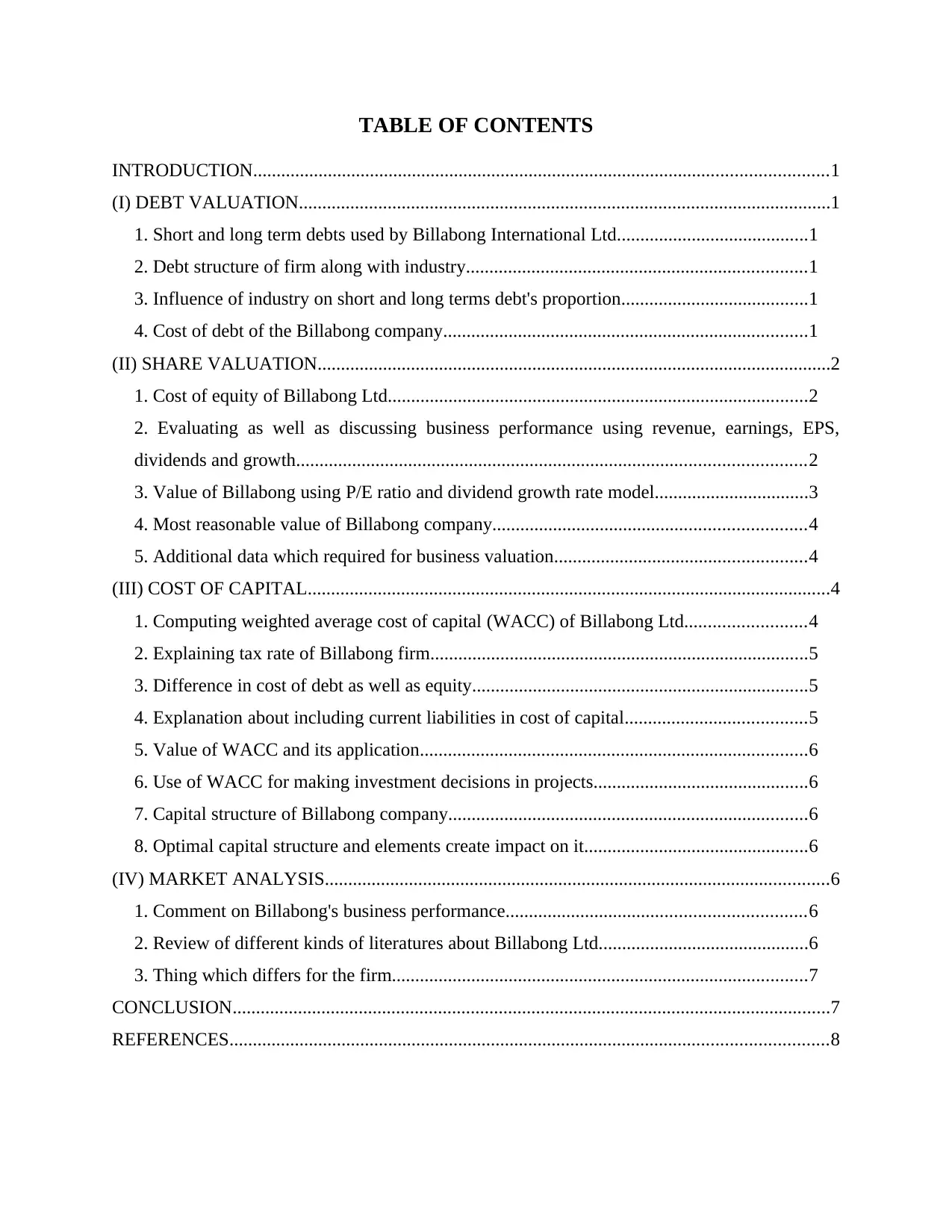
TABLE OF CONTENTS
INTRODUCTION...........................................................................................................................1
(I) DEBT VALUATION..................................................................................................................1
1. Short and long term debts used by Billabong International Ltd.........................................1
2. Debt structure of firm along with industry.........................................................................1
3. Influence of industry on short and long terms debt's proportion........................................1
4. Cost of debt of the Billabong company..............................................................................1
(II) SHARE VALUATION..............................................................................................................2
1. Cost of equity of Billabong Ltd..........................................................................................2
2. Evaluating as well as discussing business performance using revenue, earnings, EPS,
dividends and growth.............................................................................................................2
3. Value of Billabong using P/E ratio and dividend growth rate model.................................3
4. Most reasonable value of Billabong company...................................................................4
5. Additional data which required for business valuation......................................................4
(III) COST OF CAPITAL................................................................................................................4
1. Computing weighted average cost of capital (WACC) of Billabong Ltd..........................4
2. Explaining tax rate of Billabong firm.................................................................................5
3. Difference in cost of debt as well as equity........................................................................5
4. Explanation about including current liabilities in cost of capital.......................................5
5. Value of WACC and its application...................................................................................6
6. Use of WACC for making investment decisions in projects..............................................6
7. Capital structure of Billabong company.............................................................................6
8. Optimal capital structure and elements create impact on it................................................6
(IV) MARKET ANALYSIS............................................................................................................6
1. Comment on Billabong's business performance................................................................6
2. Review of different kinds of literatures about Billabong Ltd.............................................6
3. Thing which differs for the firm.........................................................................................7
CONCLUSION................................................................................................................................7
REFERENCES................................................................................................................................8
INTRODUCTION...........................................................................................................................1
(I) DEBT VALUATION..................................................................................................................1
1. Short and long term debts used by Billabong International Ltd.........................................1
2. Debt structure of firm along with industry.........................................................................1
3. Influence of industry on short and long terms debt's proportion........................................1
4. Cost of debt of the Billabong company..............................................................................1
(II) SHARE VALUATION..............................................................................................................2
1. Cost of equity of Billabong Ltd..........................................................................................2
2. Evaluating as well as discussing business performance using revenue, earnings, EPS,
dividends and growth.............................................................................................................2
3. Value of Billabong using P/E ratio and dividend growth rate model.................................3
4. Most reasonable value of Billabong company...................................................................4
5. Additional data which required for business valuation......................................................4
(III) COST OF CAPITAL................................................................................................................4
1. Computing weighted average cost of capital (WACC) of Billabong Ltd..........................4
2. Explaining tax rate of Billabong firm.................................................................................5
3. Difference in cost of debt as well as equity........................................................................5
4. Explanation about including current liabilities in cost of capital.......................................5
5. Value of WACC and its application...................................................................................6
6. Use of WACC for making investment decisions in projects..............................................6
7. Capital structure of Billabong company.............................................................................6
8. Optimal capital structure and elements create impact on it................................................6
(IV) MARKET ANALYSIS............................................................................................................6
1. Comment on Billabong's business performance................................................................6
2. Review of different kinds of literatures about Billabong Ltd.............................................6
3. Thing which differs for the firm.........................................................................................7
CONCLUSION................................................................................................................................7
REFERENCES................................................................................................................................8
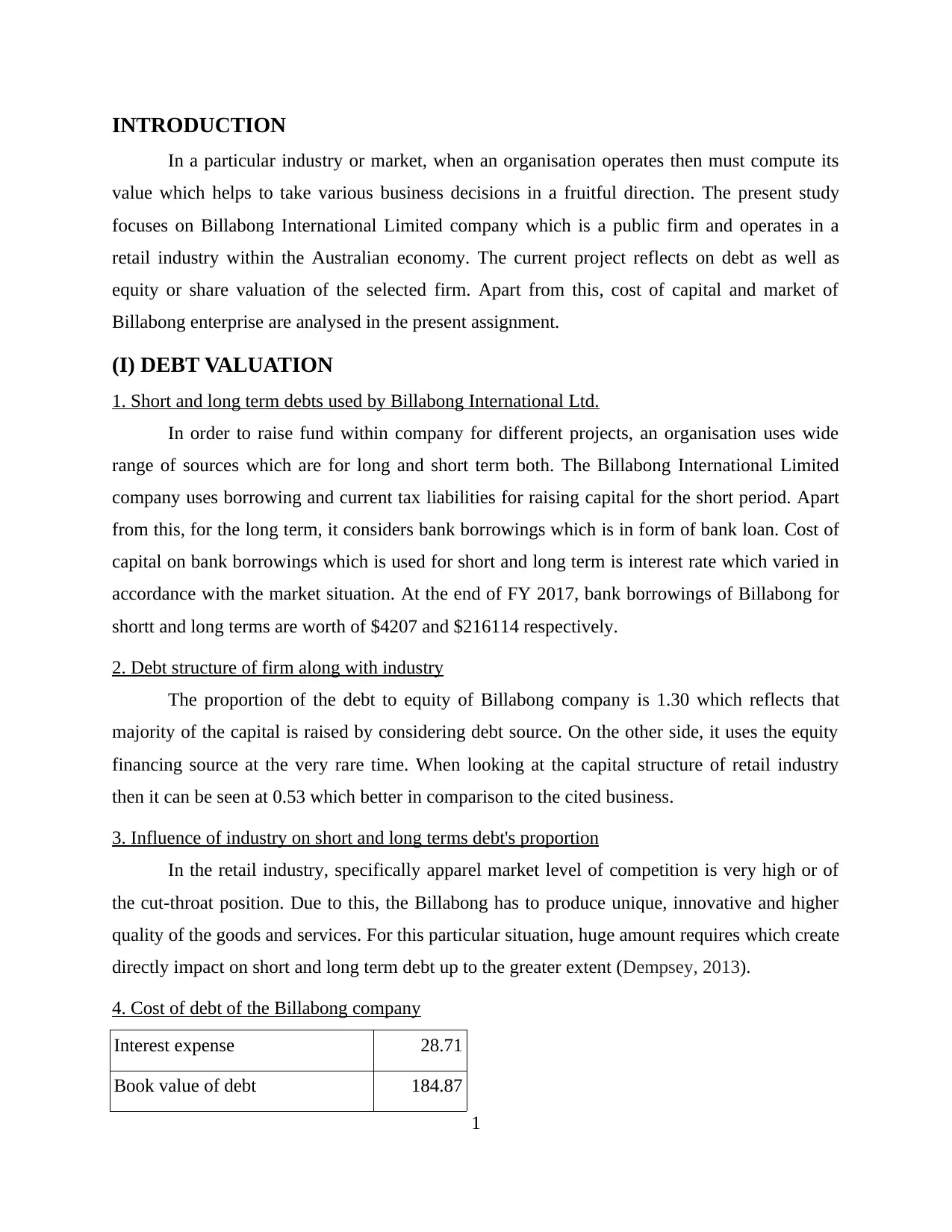
INTRODUCTION
In a particular industry or market, when an organisation operates then must compute its
value which helps to take various business decisions in a fruitful direction. The present study
focuses on Billabong International Limited company which is a public firm and operates in a
retail industry within the Australian economy. The current project reflects on debt as well as
equity or share valuation of the selected firm. Apart from this, cost of capital and market of
Billabong enterprise are analysed in the present assignment.
(I) DEBT VALUATION
1. Short and long term debts used by Billabong International Ltd.
In order to raise fund within company for different projects, an organisation uses wide
range of sources which are for long and short term both. The Billabong International Limited
company uses borrowing and current tax liabilities for raising capital for the short period. Apart
from this, for the long term, it considers bank borrowings which is in form of bank loan. Cost of
capital on bank borrowings which is used for short and long term is interest rate which varied in
accordance with the market situation. At the end of FY 2017, bank borrowings of Billabong for
shortt and long terms are worth of $4207 and $216114 respectively.
2. Debt structure of firm along with industry
The proportion of the debt to equity of Billabong company is 1.30 which reflects that
majority of the capital is raised by considering debt source. On the other side, it uses the equity
financing source at the very rare time. When looking at the capital structure of retail industry
then it can be seen at 0.53 which better in comparison to the cited business.
3. Influence of industry on short and long terms debt's proportion
In the retail industry, specifically apparel market level of competition is very high or of
the cut-throat position. Due to this, the Billabong has to produce unique, innovative and higher
quality of the goods and services. For this particular situation, huge amount requires which create
directly impact on short and long term debt up to the greater extent (Dempsey, 2013).
4. Cost of debt of the Billabong company
Interest expense 28.71
Book value of debt 184.87
1
In a particular industry or market, when an organisation operates then must compute its
value which helps to take various business decisions in a fruitful direction. The present study
focuses on Billabong International Limited company which is a public firm and operates in a
retail industry within the Australian economy. The current project reflects on debt as well as
equity or share valuation of the selected firm. Apart from this, cost of capital and market of
Billabong enterprise are analysed in the present assignment.
(I) DEBT VALUATION
1. Short and long term debts used by Billabong International Ltd.
In order to raise fund within company for different projects, an organisation uses wide
range of sources which are for long and short term both. The Billabong International Limited
company uses borrowing and current tax liabilities for raising capital for the short period. Apart
from this, for the long term, it considers bank borrowings which is in form of bank loan. Cost of
capital on bank borrowings which is used for short and long term is interest rate which varied in
accordance with the market situation. At the end of FY 2017, bank borrowings of Billabong for
shortt and long terms are worth of $4207 and $216114 respectively.
2. Debt structure of firm along with industry
The proportion of the debt to equity of Billabong company is 1.30 which reflects that
majority of the capital is raised by considering debt source. On the other side, it uses the equity
financing source at the very rare time. When looking at the capital structure of retail industry
then it can be seen at 0.53 which better in comparison to the cited business.
3. Influence of industry on short and long terms debt's proportion
In the retail industry, specifically apparel market level of competition is very high or of
the cut-throat position. Due to this, the Billabong has to produce unique, innovative and higher
quality of the goods and services. For this particular situation, huge amount requires which create
directly impact on short and long term debt up to the greater extent (Dempsey, 2013).
4. Cost of debt of the Billabong company
Interest expense 28.71
Book value of debt 184.87
1
⊘ This is a preview!⊘
Do you want full access?
Subscribe today to unlock all pages.

Trusted by 1+ million students worldwide
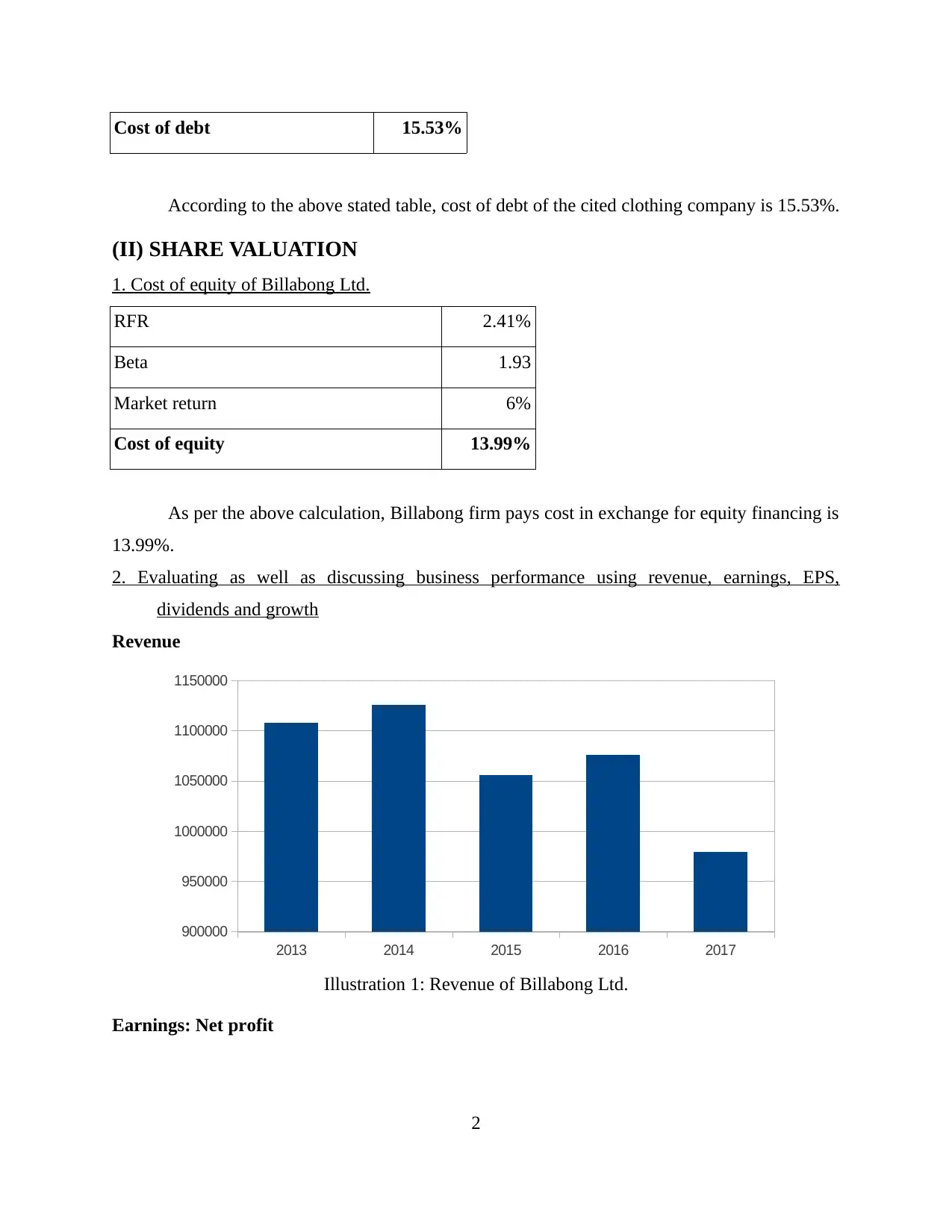
Cost of debt 15.53%
According to the above stated table, cost of debt of the cited clothing company is 15.53%.
(II) SHARE VALUATION
1. Cost of equity of Billabong Ltd.
RFR 2.41%
Beta 1.93
Market return 6%
Cost of equity 13.99%
As per the above calculation, Billabong firm pays cost in exchange for equity financing is
13.99%.
2. Evaluating as well as discussing business performance using revenue, earnings, EPS,
dividends and growth
Revenue
2013 2014 2015 2016 2017
900000
950000
1000000
1050000
1100000
1150000
Illustration 1: Revenue of Billabong Ltd.
Earnings: Net profit
2
According to the above stated table, cost of debt of the cited clothing company is 15.53%.
(II) SHARE VALUATION
1. Cost of equity of Billabong Ltd.
RFR 2.41%
Beta 1.93
Market return 6%
Cost of equity 13.99%
As per the above calculation, Billabong firm pays cost in exchange for equity financing is
13.99%.
2. Evaluating as well as discussing business performance using revenue, earnings, EPS,
dividends and growth
Revenue
2013 2014 2015 2016 2017
900000
950000
1000000
1050000
1100000
1150000
Illustration 1: Revenue of Billabong Ltd.
Earnings: Net profit
2
Paraphrase This Document
Need a fresh take? Get an instant paraphrase of this document with our AI Paraphraser

2013 2014 2015 2016 2017
-1000000
-800000
-600000
-400000
-200000
0
200000
Illustration 2: Net profit of Billabong Ltd.
EPS
2013 2014 2015 2016 2017
-140
-120
-100
-80
-60
-40
-20
0
20
Illustration 3: EPS of Billabong Ltd.
Interpretation: On the basis of revenue position it can be seen that amount of sales is
consistently declining from the FY 2013 to 2017. Apart from this, the Billabong enterprise
generates net loss in each year from last five accounting periods instead of earning net income.
Earnings per share of the cited clothing firm is also in the negative condition. When considering
to the dividend and growth then it not allows shareholders for providing dividend amount.
3. Value of Billabong using P/E ratio and dividend growth rate model
Table 1: P/E ratio and valuation of Billabong Ltd
3
-1000000
-800000
-600000
-400000
-200000
0
200000
Illustration 2: Net profit of Billabong Ltd.
EPS
2013 2014 2015 2016 2017
-140
-120
-100
-80
-60
-40
-20
0
20
Illustration 3: EPS of Billabong Ltd.
Interpretation: On the basis of revenue position it can be seen that amount of sales is
consistently declining from the FY 2013 to 2017. Apart from this, the Billabong enterprise
generates net loss in each year from last five accounting periods instead of earning net income.
Earnings per share of the cited clothing firm is also in the negative condition. When considering
to the dividend and growth then it not allows shareholders for providing dividend amount.
3. Value of Billabong using P/E ratio and dividend growth rate model
Table 1: P/E ratio and valuation of Billabong Ltd
3
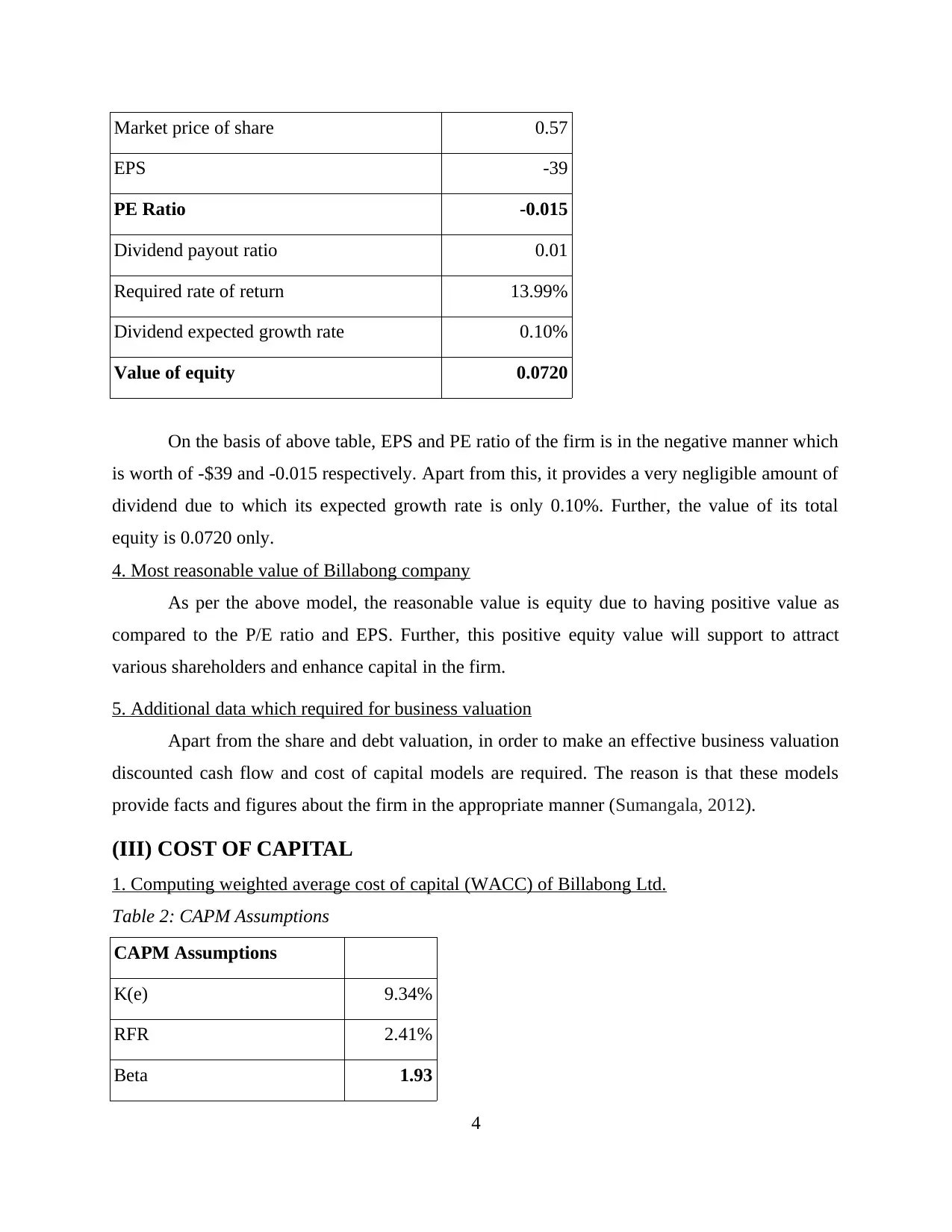
Market price of share 0.57
EPS -39
PE Ratio -0.015
Dividend payout ratio 0.01
Required rate of return 13.99%
Dividend expected growth rate 0.10%
Value of equity 0.0720
On the basis of above table, EPS and PE ratio of the firm is in the negative manner which
is worth of -$39 and -0.015 respectively. Apart from this, it provides a very negligible amount of
dividend due to which its expected growth rate is only 0.10%. Further, the value of its total
equity is 0.0720 only.
4. Most reasonable value of Billabong company
As per the above model, the reasonable value is equity due to having positive value as
compared to the P/E ratio and EPS. Further, this positive equity value will support to attract
various shareholders and enhance capital in the firm.
5. Additional data which required for business valuation
Apart from the share and debt valuation, in order to make an effective business valuation
discounted cash flow and cost of capital models are required. The reason is that these models
provide facts and figures about the firm in the appropriate manner (Sumangala, 2012).
(III) COST OF CAPITAL
1. Computing weighted average cost of capital (WACC) of Billabong Ltd.
Table 2: CAPM Assumptions
CAPM Assumptions
K(e) 9.34%
RFR 2.41%
Beta 1.93
4
EPS -39
PE Ratio -0.015
Dividend payout ratio 0.01
Required rate of return 13.99%
Dividend expected growth rate 0.10%
Value of equity 0.0720
On the basis of above table, EPS and PE ratio of the firm is in the negative manner which
is worth of -$39 and -0.015 respectively. Apart from this, it provides a very negligible amount of
dividend due to which its expected growth rate is only 0.10%. Further, the value of its total
equity is 0.0720 only.
4. Most reasonable value of Billabong company
As per the above model, the reasonable value is equity due to having positive value as
compared to the P/E ratio and EPS. Further, this positive equity value will support to attract
various shareholders and enhance capital in the firm.
5. Additional data which required for business valuation
Apart from the share and debt valuation, in order to make an effective business valuation
discounted cash flow and cost of capital models are required. The reason is that these models
provide facts and figures about the firm in the appropriate manner (Sumangala, 2012).
(III) COST OF CAPITAL
1. Computing weighted average cost of capital (WACC) of Billabong Ltd.
Table 2: CAPM Assumptions
CAPM Assumptions
K(e) 9.34%
RFR 2.41%
Beta 1.93
4
⊘ This is a preview!⊘
Do you want full access?
Subscribe today to unlock all pages.

Trusted by 1+ million students worldwide
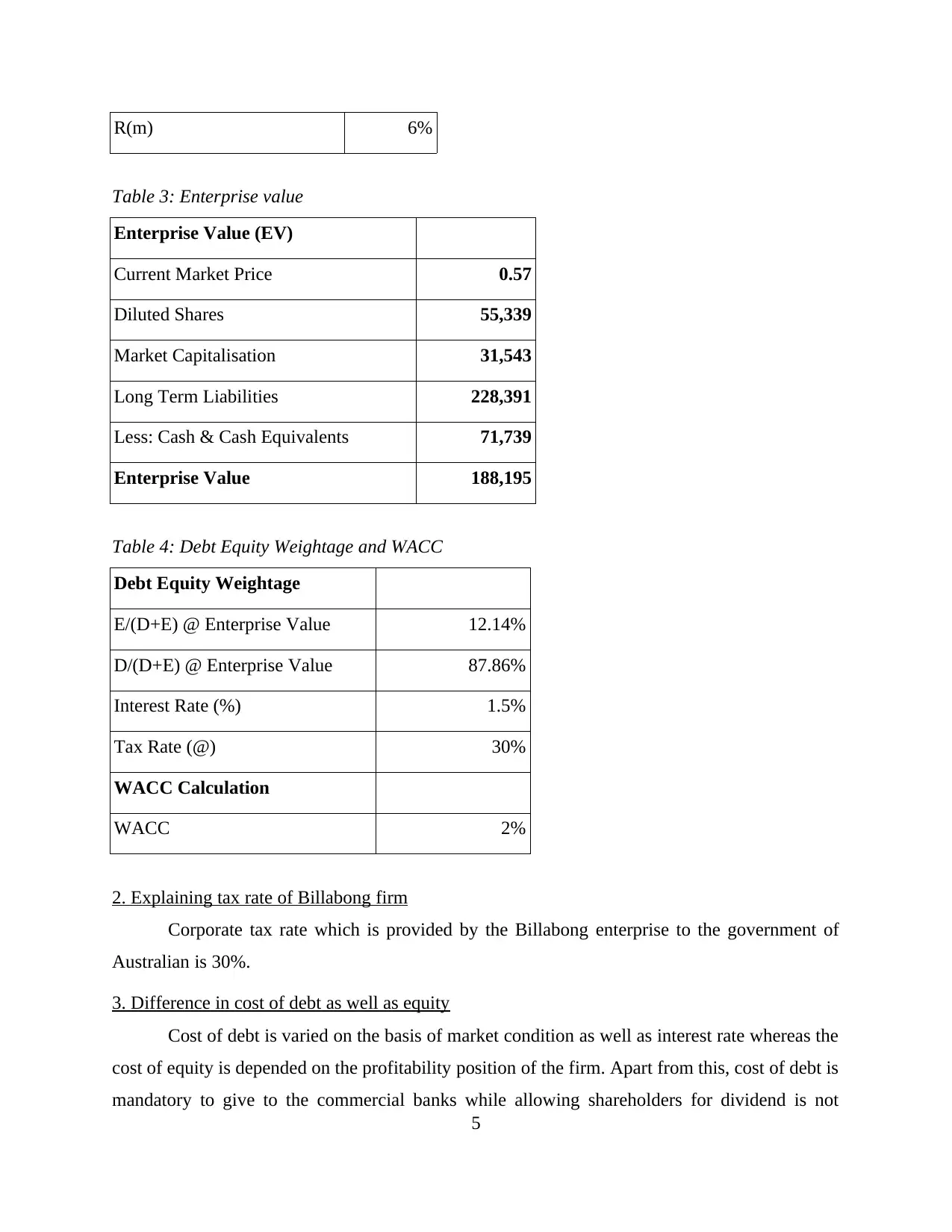
R(m) 6%
Table 3: Enterprise value
Enterprise Value (EV)
Current Market Price 0.57
Diluted Shares 55,339
Market Capitalisation 31,543
Long Term Liabilities 228,391
Less: Cash & Cash Equivalents 71,739
Enterprise Value 188,195
Table 4: Debt Equity Weightage and WACC
Debt Equity Weightage
E/(D+E) @ Enterprise Value 12.14%
D/(D+E) @ Enterprise Value 87.86%
Interest Rate (%) 1.5%
Tax Rate (@) 30%
WACC Calculation
WACC 2%
2. Explaining tax rate of Billabong firm
Corporate tax rate which is provided by the Billabong enterprise to the government of
Australian is 30%.
3. Difference in cost of debt as well as equity
Cost of debt is varied on the basis of market condition as well as interest rate whereas the
cost of equity is depended on the profitability position of the firm. Apart from this, cost of debt is
mandatory to give to the commercial banks while allowing shareholders for dividend is not
5
Table 3: Enterprise value
Enterprise Value (EV)
Current Market Price 0.57
Diluted Shares 55,339
Market Capitalisation 31,543
Long Term Liabilities 228,391
Less: Cash & Cash Equivalents 71,739
Enterprise Value 188,195
Table 4: Debt Equity Weightage and WACC
Debt Equity Weightage
E/(D+E) @ Enterprise Value 12.14%
D/(D+E) @ Enterprise Value 87.86%
Interest Rate (%) 1.5%
Tax Rate (@) 30%
WACC Calculation
WACC 2%
2. Explaining tax rate of Billabong firm
Corporate tax rate which is provided by the Billabong enterprise to the government of
Australian is 30%.
3. Difference in cost of debt as well as equity
Cost of debt is varied on the basis of market condition as well as interest rate whereas the
cost of equity is depended on the profitability position of the firm. Apart from this, cost of debt is
mandatory to give to the commercial banks while allowing shareholders for dividend is not
5
Paraphrase This Document
Need a fresh take? Get an instant paraphrase of this document with our AI Paraphraser

compulsory except preference shares. Moreover, cost debt is greater at a majority of the times in
comparison to equity cost (Barth, Konchitchki and Landsman, 2013).
4. Explanation about including current liabilities in cost of capital
When the current liabilities are involved under cost of capital then manager able to
measure its actual financial performance in the operating industry. Further, by including the CL
in the cost of capital, firm is supportive in order to make an effective business valuation.
However, it creates little tough for the accountants in order to make proper accounting treatments
and adjustments in financial statements.
5. Value of WACC and its application
In the Billabong International Ltd enterprise, WACC is 2% only which is very low within
the industry. Further, it is applied by the banks or financing sources at the time of allowing firm
for providing capital in order to make an effective business valuation (Kim and Sohn, 2013).
6. Use of WACC for making investment decisions in projects
With the help of weighted average cost of capital the company able to compute
discounted cash flow of the project. On the basis of the computed discounted cash flow net
present value of the total investment is to be determined which helps to make decision that
whether money should put in a particular project or not.
7. Capital structure of Billabong company
The capital structure of any company comprises with major two factors which are like
debt and equity (Pant, 2017). It is 0.30:1 with reference to the Billabong Ltd which is very in
comparison to standard proportion i.e. 0.5:1.
8. Optimal capital structure and elements create impact on it
The optimal capital structure is 0.5:1 where debt amount should be just half of the equity
capital in the workplace. Further, factors which create impact on capital structure are like cash
flow position, cost of debt and equity, tax rate, ROI, stock market situation, risk consideration etc
(Samiksha, 2017).
6
comparison to equity cost (Barth, Konchitchki and Landsman, 2013).
4. Explanation about including current liabilities in cost of capital
When the current liabilities are involved under cost of capital then manager able to
measure its actual financial performance in the operating industry. Further, by including the CL
in the cost of capital, firm is supportive in order to make an effective business valuation.
However, it creates little tough for the accountants in order to make proper accounting treatments
and adjustments in financial statements.
5. Value of WACC and its application
In the Billabong International Ltd enterprise, WACC is 2% only which is very low within
the industry. Further, it is applied by the banks or financing sources at the time of allowing firm
for providing capital in order to make an effective business valuation (Kim and Sohn, 2013).
6. Use of WACC for making investment decisions in projects
With the help of weighted average cost of capital the company able to compute
discounted cash flow of the project. On the basis of the computed discounted cash flow net
present value of the total investment is to be determined which helps to make decision that
whether money should put in a particular project or not.
7. Capital structure of Billabong company
The capital structure of any company comprises with major two factors which are like
debt and equity (Pant, 2017). It is 0.30:1 with reference to the Billabong Ltd which is very in
comparison to standard proportion i.e. 0.5:1.
8. Optimal capital structure and elements create impact on it
The optimal capital structure is 0.5:1 where debt amount should be just half of the equity
capital in the workplace. Further, factors which create impact on capital structure are like cash
flow position, cost of debt and equity, tax rate, ROI, stock market situation, risk consideration etc
(Samiksha, 2017).
6

(IV) MARKET ANALYSIS
1. Comment on Billabong's business performance
When looking at the overall performance of the selected retail company then it can be
said that revenue and net profit generation capacity is declining over the period of last five years.
Apart from this, the proportion of debt is also too much high as compared to industry average.
Further, not provided any kind of return to the shareholders which is also a sign of negative
business performance. Henceforth, the Billabong International Ltd organisation is performing
very poor in its respective industry.
2. Review of different kinds of literatures about Billabong Ltd.
On the position of Billabong enterprise most of the literature percept that it does not
perform well in the industry in terms of products and financial both. Further, its sales revenue is
reducing on a consistent basis from the last five years in the Australian economy. Further, it can
be said by literature that, it has a better opportunity to produce highly attractive, trendy and
fashionable cloths. Due to this, Billabong will be able to attract huge customers and boost up
financial performance (Billabong International Limited, 2017). On such statements provided by
literature I am totally agreed because this firm does not provide highly trendy and fashionable
cloths in the present times.
3. Thing which differs for the firm
In the retail industry, all the financial data and specifically capital structure differs from
the market. As per this, market capital structure is only 0.53 whereas the same is 1.30 in
Billabong entity.
CONCLUSION
On the basis of the above analysis, it can be said that cost of debt and equity is 15.53%
and 13.99% in Billabong International Ltd enterprise. Further, its performance in terms of
generating revenue and earnings is extremely poor from last five years. Along with this, not
allowing shareholders for providing dividend amount on shares purchased by them. Moreover, it
should modify and make changes in present capital structure as it is 1.30 as of now.
7
1. Comment on Billabong's business performance
When looking at the overall performance of the selected retail company then it can be
said that revenue and net profit generation capacity is declining over the period of last five years.
Apart from this, the proportion of debt is also too much high as compared to industry average.
Further, not provided any kind of return to the shareholders which is also a sign of negative
business performance. Henceforth, the Billabong International Ltd organisation is performing
very poor in its respective industry.
2. Review of different kinds of literatures about Billabong Ltd.
On the position of Billabong enterprise most of the literature percept that it does not
perform well in the industry in terms of products and financial both. Further, its sales revenue is
reducing on a consistent basis from the last five years in the Australian economy. Further, it can
be said by literature that, it has a better opportunity to produce highly attractive, trendy and
fashionable cloths. Due to this, Billabong will be able to attract huge customers and boost up
financial performance (Billabong International Limited, 2017). On such statements provided by
literature I am totally agreed because this firm does not provide highly trendy and fashionable
cloths in the present times.
3. Thing which differs for the firm
In the retail industry, all the financial data and specifically capital structure differs from
the market. As per this, market capital structure is only 0.53 whereas the same is 1.30 in
Billabong entity.
CONCLUSION
On the basis of the above analysis, it can be said that cost of debt and equity is 15.53%
and 13.99% in Billabong International Ltd enterprise. Further, its performance in terms of
generating revenue and earnings is extremely poor from last five years. Along with this, not
allowing shareholders for providing dividend amount on shares purchased by them. Moreover, it
should modify and make changes in present capital structure as it is 1.30 as of now.
7
⊘ This is a preview!⊘
Do you want full access?
Subscribe today to unlock all pages.

Trusted by 1+ million students worldwide
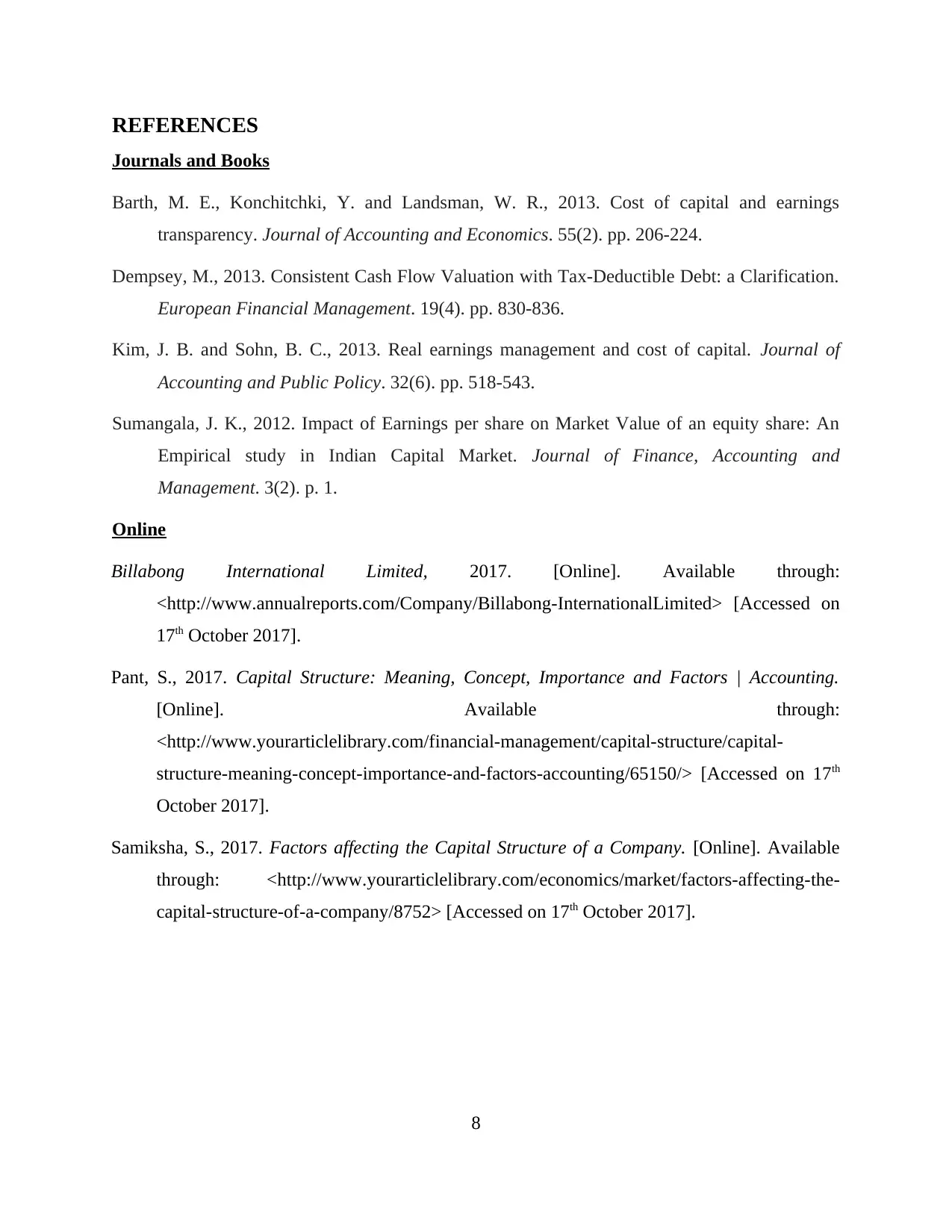
REFERENCES
Journals and Books
Barth, M. E., Konchitchki, Y. and Landsman, W. R., 2013. Cost of capital and earnings
transparency. Journal of Accounting and Economics. 55(2). pp. 206-224.
Dempsey, M., 2013. Consistent Cash Flow Valuation with Tax‐Deductible Debt: a Clarification.
European Financial Management. 19(4). pp. 830-836.
Kim, J. B. and Sohn, B. C., 2013. Real earnings management and cost of capital. Journal of
Accounting and Public Policy. 32(6). pp. 518-543.
Sumangala, J. K., 2012. Impact of Earnings per share on Market Value of an equity share: An
Empirical study in Indian Capital Market. Journal of Finance, Accounting and
Management. 3(2). p. 1.
Online
Billabong International Limited, 2017. [Online]. Available through:
<http://www.annualreports.com/Company/Billabong-InternationalLimited> [Accessed on
17th October 2017].
Pant, S., 2017. Capital Structure: Meaning, Concept, Importance and Factors | Accounting.
[Online]. Available through:
<http://www.yourarticlelibrary.com/financial-management/capital-structure/capital-
structure-meaning-concept-importance-and-factors-accounting/65150/> [Accessed on 17th
October 2017].
Samiksha, S., 2017. Factors affecting the Capital Structure of a Company. [Online]. Available
through: <http://www.yourarticlelibrary.com/economics/market/factors-affecting-the-
capital-structure-of-a-company/8752> [Accessed on 17th October 2017].
8
Journals and Books
Barth, M. E., Konchitchki, Y. and Landsman, W. R., 2013. Cost of capital and earnings
transparency. Journal of Accounting and Economics. 55(2). pp. 206-224.
Dempsey, M., 2013. Consistent Cash Flow Valuation with Tax‐Deductible Debt: a Clarification.
European Financial Management. 19(4). pp. 830-836.
Kim, J. B. and Sohn, B. C., 2013. Real earnings management and cost of capital. Journal of
Accounting and Public Policy. 32(6). pp. 518-543.
Sumangala, J. K., 2012. Impact of Earnings per share on Market Value of an equity share: An
Empirical study in Indian Capital Market. Journal of Finance, Accounting and
Management. 3(2). p. 1.
Online
Billabong International Limited, 2017. [Online]. Available through:
<http://www.annualreports.com/Company/Billabong-InternationalLimited> [Accessed on
17th October 2017].
Pant, S., 2017. Capital Structure: Meaning, Concept, Importance and Factors | Accounting.
[Online]. Available through:
<http://www.yourarticlelibrary.com/financial-management/capital-structure/capital-
structure-meaning-concept-importance-and-factors-accounting/65150/> [Accessed on 17th
October 2017].
Samiksha, S., 2017. Factors affecting the Capital Structure of a Company. [Online]. Available
through: <http://www.yourarticlelibrary.com/economics/market/factors-affecting-the-
capital-structure-of-a-company/8752> [Accessed on 17th October 2017].
8
1 out of 10
Related Documents
Your All-in-One AI-Powered Toolkit for Academic Success.
+13062052269
info@desklib.com
Available 24*7 on WhatsApp / Email
![[object Object]](/_next/static/media/star-bottom.7253800d.svg)
Unlock your academic potential
Copyright © 2020–2025 A2Z Services. All Rights Reserved. Developed and managed by ZUCOL.





